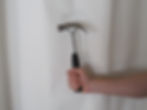All about Hammers
- SkillCat Team
- Mar 26
- 7 min read
Key Hand Tools: Chapter 2
Introduction to Hammers
This module will teach you:
- How to drive a nail,
- How to remove a nail, and
- How to use different types of hammers Skip to quiz!
Using a Hammer
A hammer is used to strike objects. For example, a hammer can drive a nail through wood. A hammer is made of:
A head and
A handle
You hold the hammer at the handle. The head of the hammer is used to strike fasteners or others objects.
Recall that a nail is a fastener with a smooth shaft. A hammer is commonly used to install and remove nails. For example, the metal head of a hammer can strike a nail through two pieces of plywood.
A hammer is always held by the handle. The hammer handle will rest across your palm, and your fingers will close around the handle. Depending on the situation, you will hold the hammer closer or farther from the head.

Holding the hammer close to the head allows for more stability and control. More control of the hammer reduces the chance that you will injure yourself or the material. In general, it is better to start with your hand closer to the head.
Holding the hammer farther from the head allows you to hit objects with more power. The farther your hand is from the head, the more power you will have.
The head of a hammer can have different weights. The heavier the head, the more power you have when hammering.
Hammer heads are measured in ounces (oz). The most common head weights are 16 oz and 20 oz. A 16 oz head will give you less power. 16 oz heads are used for smaller jobs like installing trim. A 20 oz head will give you more power. 20 oz heads are better for heavy-duty jobs like framing walls.
The length of a hammer handle can vary. A longer handle gives you more leverage. More leverage allows you to strike fasteners harder while working less hard.
A hammer must be used safely to avoid injuring yourself. Make sure no one is within swinging distance when using a hammer. Keep secure footing and have good balance.
Inspect the hammer before you start using it. Do not use a hammer with a cracked, splintered, or loosely attached handle. Do not use a hammer with a head that is dented or cracked.
A hammer is an effective tool for striking objects. The head of a hammer is used to strike fasteners. You can hold the hammer closer to the head for more control.
Types of Hammers
This module will teach you:
- How to drive a nail,
- How to remove a nail, and
- How to use different types of hammers Skip to quiz!
Types of Hammers

There are several types of hammers, including:
Claw hammers,
Ball peen hammers, and
Club hammers.
Each type of hammer has unique strengths and weaknesses.
Claw Hammer
A claw hammer has a head with a flat end on one side and a ‘V’ shaped claw on the other side. The flat end of the head is used to strike nails. The claw side of the head removes nails. Claw hammers are the most common hammer you will see in the field.
A claw hammer should be used when you expect to be working with nails. Claw hammers excel at hammering nails into wood. Claw hammers are also excellent at removing nails from
material.
Since claw hammers are commonly used on nails, we will teach you how to hammer a nail into wood. The next slides will go step by step through the process of hammering a nail.
Check the area to make sure that you will not hit anyone. Inspect the hammer to confirm that it is in good condition. Look for cracks, chicks, or breaks on the handle and hammer head.
Next, we need to inspect the material we are going to drive the nail into. It is important for the object to be stable. Striking an unstable object can result in the nail slipping, hitting your hand with the hammer, or other injuries.
To start a nail, place the pointed end of the nail on the wood. Hold the nail with your thumb and forefinger directly below the head. Holding a nail near the point can cause injury.
Once the nail is in the correct position, grab your hammer. Hold the hammer with your dominant hand. Keep your hand close to the head when starting a nail. This gives you more control.
Gently tap the head of the hammer onto the head of the nail. You should see the point of the nail going into the wood. This can take several taps. When the nail is firmly attached to the wood, you can stop holding the nail with your fingers.
Once the point of the nail is inserted into the material, the nail has been “started”. You should not need to hold the nail at this point.
Adjust your grip, so you are holding the hammer closer to the bottom of the handle. Continue hammering the nail until the head is flat with the wood. This will require several strong strikes. When the head of the nail is flush with the wood, you can stop hammering.
When you are striking the hammer, make sure to strike the head of the nail at a 90-degree angle. When the hammer contacts the nail, it should drive the nail straight into the wood.
Hitting the nail at an angle can cause the nail to bend or not enter the wood correctly.
Claw hammers can also remove nails. To remove nails, you will use the claw end of the hammer. Recall that the claw is opposite of the flat head. The claw looks like a metal “V”.
Start by sliding the V-shaped claw under the nail head. The claw should be pointed away from you. As you slide the claw towards the nail head, the nail head will go towards the bottom of the V. Once the nail is in the V, you should not be able to lift your hammer up.
Recall, a longer handle creates more leverage. Place your hand on the end of the handle. Slowly pull the hammer towards yourself until the claw and nail start lifting upwards.
Continue pulling the hammer towards you until the nail comes loose. When you are pulling the handle towards yourself, the hammer is putting pressure into the wood. This pressure can damage the wood if you are not careful.
To avoid damaging the wood under the nail head, we use a shim. A shim is a thin piece of wood shaped like a right triangle. Placing a shim under the hammer head can protect the wood while you remove the nail.
To insert a shim, place the claw underneath the head of the nail. Slide a shim underneath the head of the hammer. Pull the handle of the hammer until the nail is removed. The shim also gives you more leverage. Shims make it easier to pull out nails.
Ball Peen Hammer
A Ball Peen Hammer is another type of hammer. The head of a ball peen hammer has a flat side and a round side. The round side is known as the peen.
A ball peen hammer is designed to be used on metal. The flat end of the hammer is used for flattening metals. The peen end is used for shaping metal.
Ball peen hammers are great at flattening small pieces of sheet metal. Press the sheet metal against a flat surface. Repeatedly strike the sheet metal with the flat end of a hammer to straighten the sheet metal.
To shape sheet metal, clamp the sheet metal into a vice. The metal should not have a surface underneath it. Hit the metal with the peen end of the hammer. As you strike the metal, the metal will bend.
Club Hammer

A club hammer has a head with two flat faces. The club hammer is a smaller version of the sledgehammer. The head of a club hammer is the same on both sides.
A club hammer has a heavy head weight, which makes it useful for light demolition. The head weight makes it ideal for hammering in heavy stakes or breaking down old equipment.
There are several types of hammers, including:
Claw hammers,
Ball peen hammers, and
Club hammers
You will be safer and more effective when you use the correct hammer for the job.
Question #1: A heavier hammer head allows you to:
Strike nails with more force
Reach farther distances
Hold the hammer differently
Looks cool on the job site
Scroll down for the answer...

Answer: Strike nails with more force
A, a heavier hammer head allows you to strike nails with more force.
Question #2: Why do we hold a hammer at the end of the handle?
To give us more leverage
It gives us more control of the hammer
It is more safe
It is the ideal position for starting a nail
Scroll down for the answer...

Answer: To give us more leverage.
Holding a hammer at the end of the hammer gives us more leverage. This is great for providing more force when inserting or removing a nail.
Question #3: Which hammer is best for shaping metal?
Claw Hammer
Club Hammer
Ball Peen Hammer
Jack Hammer
Scroll down for the answer...

Answer: Ball Peen Hammer
A ball peen hammer has a flat head for flattening metal and a peen head for shaping metal.
Question #4: Which of these steps is not correct when hammering a nail?
Gently tap the nail with the hammer to fix it into the wood.
Hammer the nail until the head is embedded into the wood.
Place the pointed end of the nail where you want to drive it.
Hold the nail at the bottom when you start hammering.
Scroll down for the answer...

Answer: Hold the nail at the bottom when you start hammering.
Holding the nail at the bottom increases the risk of injury. You should hold the nail directly below the nail head to avoid hitting your fingers with the hammer.
Question #5: A club hammer has what kind of head?
A head with a flat face on one end and a claw on the other end
A head with two flat faces
A head with a flat face and a rounded face
A head with two rounded faces
Scroll down for the answer...

Answer: A head with two flat faces.
A club hammer has two flat faces. This allows it to be used easily for light demolition jobs.
Other References: